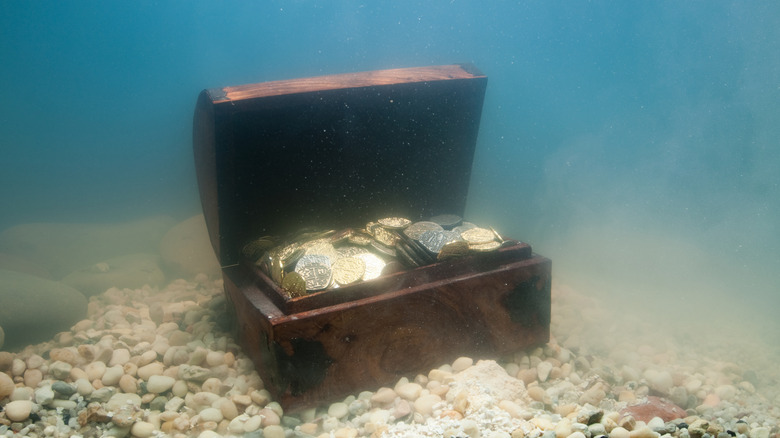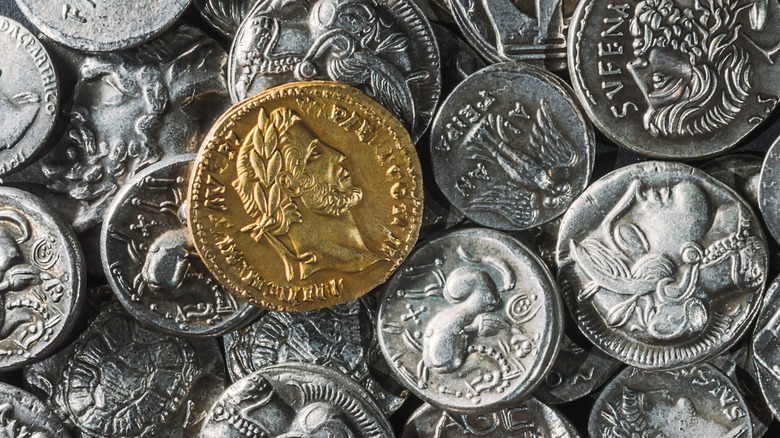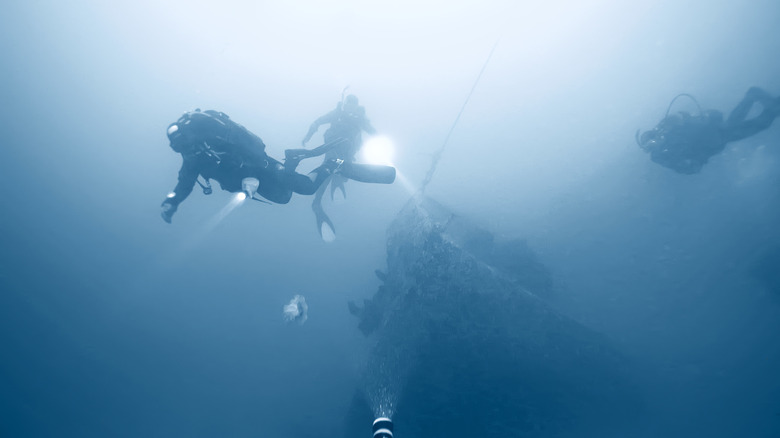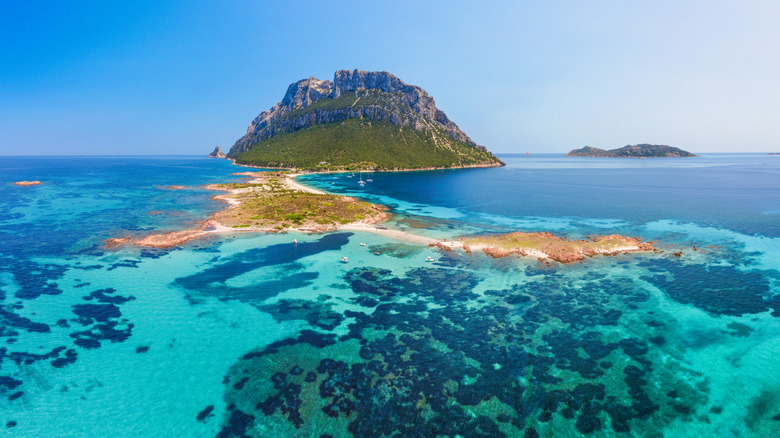Thousands Of Roman Coins Discovered May Lead To An Even Bigger Treasure
Who can resist a good sunken treasure tale? You've got shiny underwater objects, ancient mysteries, and intrepid explorers venturing into the dark, watery depths in search of untold wealth and fame. And just like striking it lucky while gambling, there's always the chance that there's more somewhere waiting to be found. Sometimes, this even happens. And sometimes, there's a whole 30,000 to 50,000 coins just begging to see the light.
No, you didn't misread that. In November 2023, a diver off the coast of the Italian island of Sardinia in the Mediterranean Sea just happened to come across a monstrous trove of bronze and copper coins. There were so many, in fact, that the Italian Ministry of Culture could only estimate how many there were based on weight — hence the 30,000 to 50,000 figure.
But more than just random nubs of circular metal, these coins come from nowhere else than the late Roman Empire, between 324 and 340 C.E. This range of years is even more shocking because it dates to the reign of Emperor Constantine I (324 to 337 C.E.), one of the most critical figures not only in Roman history but arguably all of Western Christendom. It was Constantine who converted to Christianity and set the example for the rest of Rome to follow. Per Popular Mechanics the ministry said the coins are in an "excellent and rare state of preservation." On top of all this, there were also thin-necked jugs found near the coins, which suggests the possibility of something even more impressive hidden beneath the waves: A nearby shipwreck, possibly with treasure.
The true value of finding ancient coins
When hearing about a cache of ancient coins, some people's minds shift to one thing: money. After all, we're talking about "sunken treasure" and all that, right? Well, the diver in question — or divers (plural), as some sites say — didn't become rich. He did the smart and responsible thing by contacting Italy's Ministry of Culture. That's because coins serve as one of archaeology's most valuable gateways to understanding and appreciating past peoples. As Archaeology Expert expertly puts it, they are "a great spokesperson of history."
Metal coins first pop up in the historical record around the seventh century 600 B.C.E. as a clever medium for commodity exchange. They tell us about the everyday lives and needs of people, and they also hold inherent religious and political meaning. What was inscribed on the coin, for instance? Whose face? Will future archaeologists think the U.S. quarter depicts the portrait of a god? Probably not, because future archaeologists will have access to a deluge of written and digital records. For us in the present, coins are sometimes the only thing we have to construct a portrait of the past.
To illustrate, we can look at coins from the reign of Constantine I, the same era to which the newly discovered trove dates. As the British Museum shows, coins from early in Constantine's reign in 327 tell a largely illiterate public a story of imperial victory. Constantine's standard is slaying a serpent, an act that also carries Christian connotations.
A well-preserved horde of coins
We mentioned that the coins in the current find off the coast of Sardinia are extremely well-preserved. Of course, we all know that metal doesn't fare too well in saltwater. Copper, like some of the coins in the find, eventually corrodes. And yet, as Popular Science tells us, only four out of 30,000 to 50,000 coins — yes, four — show any signs of damage whatsoever. How is this possible?
We have Roman money storage techniques to thank for the preserved state of the coins. They were a particular mint called "follis," the term for a type of leather bag or similar container. Follis coins came in bagged bundles of a particular quantity — a sack of a certain weight represented the equivalent of a modern-day bill. These coins were introduced into the Roman economy during the reign of Emperor Diocletian (284 to 305 C.E.) not too long before Constantine I came into power. Diocletian wanted to use follis coins to re-standardize Roman currency because a whole bunch of previous rulers (very stupidly) minted their own unique currencies over preceding generations. This contributed to the economic troubles of the time.
The current find reminds us that Constantine I wisely carried on Diocletian's currency-reforming measure. It's a good thing, too, as the coins will help shed light on history. "The restoration and conservation operations of the coins and materials found will allow us to expand and deepen our knowledge of the context of the finds from which a lot of information can still be extracted," Italy's Ministry of Culture said in a statement, per Heritage Daily.
Hints of a nearby shipwreck
Tens of thousands of bronze and copper coins aren't exactly easy to carry around. So if all this metal made its way into the Mediterranean Sea off the coast of Sardinia, the question begs: How did it get there? The diver(s) found the trove of coins in a mass of seagrass near the town of Arzachena in the northeast of Sardinia. Seagrass lives at depths of a mere 3 feet all the way to 190 feet. Since the divers saw a little glint that caught their attention, which means that the coins were at a shallow-enough depth for them to notice light striking them. And while we suppose someone could have carted big bags of coins to the nearest beach and swam one-armed out into the ocean, folles in tow, that seems ridiculous. More likely, the current find points to one cause: a mysterious shipwreck.
When border police arrived on the scene of the discovery, they also found the remnants of twin-handled, thin-necked jugs. This kind of container is known as an "amphora," and it was used to store liquids like wine, milk, oil, and also food like grains. Like many things, the Romans adopted the use of amphorae from the Greeks before them, who painted the vases with artwork. The presence of amphorae near the coins indicates that both got swallowed up by the sea when a ship sank — realistically a merchant vessel. Only time will tell, same as it will tell if more coin caches remain hidden in nearby waters.



